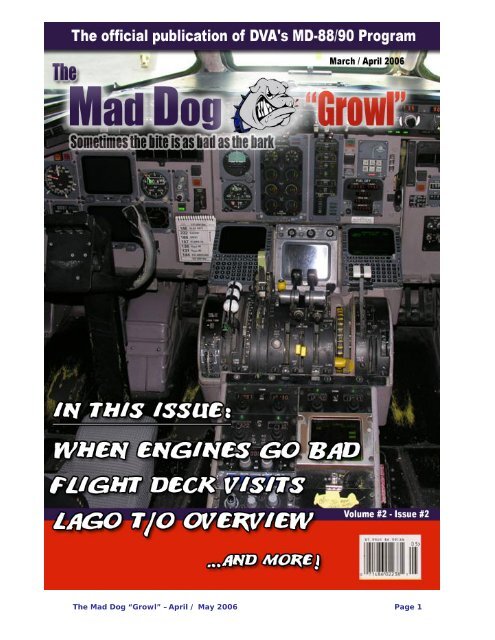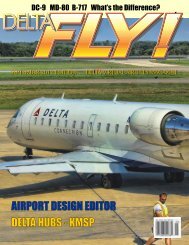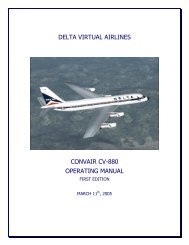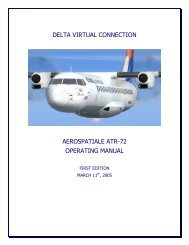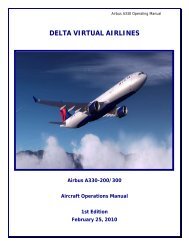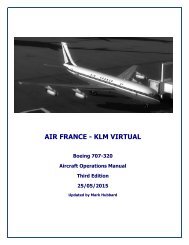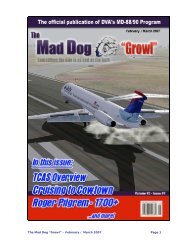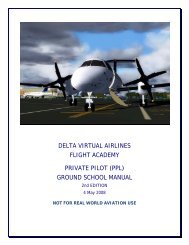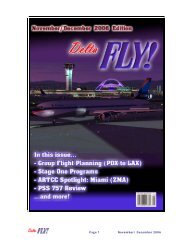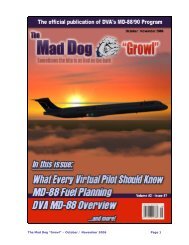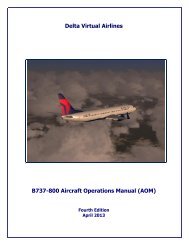The Mad Dog âGrowlâ âApril / May 2006 Page 1 - Delta Virtual Airlines
The Mad Dog âGrowlâ âApril / May 2006 Page 1 - Delta Virtual Airlines
The Mad Dog âGrowlâ âApril / May 2006 Page 1 - Delta Virtual Airlines
Create successful ePaper yourself
Turn your PDF publications into a flip-book with our unique Google optimized e-Paper software.
<strong>The</strong> <strong>Mad</strong> <strong>Dog</strong> “Growl” –April / <strong>May</strong> <strong>2006</strong> <strong>Page</strong> 1
This Month’s Features:<br />
Monthly Articles<br />
Program News........................3<br />
Recent Promotions ..................3<br />
<strong>Mad</strong> <strong>Dog</strong>s In <strong>The</strong> News ............4<br />
Featured Articles<br />
Flight Deck Visits ....................7<br />
Training Info From <strong>The</strong> Pro.......9<br />
When Engines Go Bad .............10<br />
Flight Spotlight (CVG to YYZ)....15<br />
Taxi and Takeoff Overview .......18<br />
Photo Credits:<br />
• Nathan Rasch<br />
• David Scott<br />
• Craig Davidson<br />
• Mike Evans<br />
April / <strong>May</strong> <strong>2006</strong><br />
Volume #2 – Issue #3<br />
On the Cover:<br />
MD-88 Flight deck photo from Mike Evans<br />
Newsletter Editor:<br />
Larry Foltran (DVA1679) delta1679@sbcglobal.net<br />
Program Chief Pilot:<br />
Larry Foltran (DVA1679) delta1679@sbcglobal.net<br />
Program Asst. Chief Pilot:<br />
Tyrone Weston (DVA085) dmain3v3nt@aol.com<br />
<strong>Delta</strong> <strong>Virtual</strong> <strong>Airlines</strong> (DVA) is in no way affiliated with <strong>Delta</strong> Air<br />
Lines or any of its subsidiaries. <strong>The</strong> information contained in this<br />
document is for flight simulation use only. This document is<br />
freeware only.<br />
All Rights Reserved. This publication may not be reproduced, in<br />
part or its entirety, without the expressed permission of DVA and<br />
the Editor. Images used are copyrighted by their respective<br />
owners.<br />
<strong>The</strong> <strong>Mad</strong> <strong>Dog</strong> “Growl” –April / <strong>May</strong> <strong>2006</strong> <strong>Page</strong> 2
MD88/90 Program News<br />
New MD-88/90 Manual Revision<br />
A revision of the DVA MD-88/90 Manual is currently<br />
in the works. Actually, it has been for quite some<br />
time and is (hopefully) close to completion. It will<br />
feature an in-depth history of the aircraft series,<br />
detailed specs and plenty of flying tips & guidelines.<br />
Keep an eye out for it!<br />
* * *<br />
Guest Writers Welcome!<br />
Do you have an idea for an article topic? Would<br />
you like to submit an article for the next issue of<br />
the <strong>Mad</strong> <strong>Dog</strong> Newsletter? Please contact Larry<br />
Foltran (delta1679@sbcglobal.net) to submit your<br />
idea. You will of course be credited for any<br />
information you send in.<br />
Recent Promotions<br />
Every month, we like to acknowledge our <strong>Mad</strong> <strong>Dog</strong><br />
pilots who have completed all of the requirements<br />
necessary to wear the extra stripe. Congratulations<br />
to all on your promotion.<br />
Andrew Dube (DVA2170) – Captain (Apr)<br />
Richard Williams (DVA3025) – Captain (Apr)<br />
Kenneth Davis (DVA3017) – Captain (Apr)<br />
Brian Myers (DVA339) – Captain (Apr)<br />
Jack Hendricks (DVA2936) – Captain (Apr)<br />
Adam Brown (DVA1354) – Captain (Apr)<br />
Michael Schlabowske (DVA3050) – Captain (Apr)<br />
Zachary Fleming (DVA3038) – Captain (Apr)<br />
Joel Wright (DVA2939) – Captain (Apr)<br />
David Taylor (DVA3076) – Captain (Apr)<br />
Mark Celestine (DVA2309) – Captain (Apr)<br />
Scott James (DVA2790) – Captain (Apr)<br />
Rob Berry (DVA2870) – Captain (Apr)<br />
* * *<br />
Wanted – <strong>Mad</strong> <strong>Dog</strong> Screenshots!<br />
We’re always looking for excellent and unique<br />
screenshots or photos. If you have one that we can<br />
use in the newsletter, please send it in.<br />
(delta1679@sbcglobal.net) All submissions must<br />
be your original work. Please do not submit<br />
screenshots you have not taken or photos from<br />
online aviation photo sites.<br />
<strong>The</strong> <strong>Mad</strong> <strong>Dog</strong> “Growl” –April / <strong>May</strong> <strong>2006</strong> <strong>Page</strong> 3
<strong>Mad</strong> <strong>Dog</strong>s In <strong>The</strong> News<br />
Shuttle Bus Hits Plane at Metro<br />
Airport<br />
By Anu Prakash<br />
Web produced by Sarah Morgan<br />
April 7, <strong>2006</strong><br />
An employee shuttle bus clipped the wing of a<br />
Northwest DC 9 airplane that was parked at a gate,<br />
Friday at Metro Airport.<br />
Airplane business heads into California<br />
sunset<br />
Final Boeing 717 rolls out of factory; future<br />
uncertain for C-17 cargo carrier<br />
<strong>The</strong> Associated Press<br />
Updated: 5:57 p.m. ET April 23, <strong>2006</strong><br />
LONG BEACH, Calif. - <strong>The</strong> last Boeing 717 has left<br />
the factory.<br />
<strong>The</strong> slender airliner, trailed by dozens of the workers<br />
who built it, was rolled out before dawn last week<br />
and towed across a boulevard to Long Beach<br />
Airport.<br />
Its delivery to AirTran Airways next month will mark<br />
the end of seven decades of commercial airplane<br />
production in Southern California.<br />
At another sprawling complex nearby, thousands of<br />
workers still produce the Boeing C-17 military cargo<br />
plane. However, there are no new orders for the<br />
aircraft in the proposed Defense Department budget.<br />
Investigators said, the plane was at the gate and<br />
passengers were boarding the plane, which was<br />
headed to Syracuse, New York. <strong>The</strong> plane moved<br />
slightly, but no one on board was injured.<br />
Investigators said the plane was slightly damaged.<br />
Metro Airport spokesman Mike Conway said, "<strong>The</strong><br />
bus sustained a little bit more damage; had a<br />
smashed up windshield. <strong>The</strong>re were six people on<br />
the bus that wanted [medical attention]. From my<br />
understanding, almost all of them have been cleared<br />
to return to work. Just basically bumps and bruises."<br />
Investigators are not sure if the bus driver had a<br />
medical condition or if speed was a factor.<br />
<strong>The</strong> passengers on the plane were transferred to<br />
another aircraft and have left for Syracuse. <strong>The</strong><br />
plane will be tested to make sure it is structurally<br />
sound.<br />
If congressional efforts to restore the program fail,<br />
the last of those flying warehouses will be delivered<br />
in 2008, and all airplane production would end in<br />
California — once the center of commercial and<br />
military airplane construction in the nation.<br />
“More aviation history has been made in Southern<br />
California than in any other place in the world,” said<br />
Bill Schoneberger, author of “California Wings,” a<br />
history of aviation in the state.<br />
“But we’ve evolved. <strong>The</strong> aeronautics industry has<br />
moved from an airplane business into a systems<br />
business,” he said.<br />
Indeed, as corporate consolidation and defense cuts<br />
sent airplane production to Seattle, St. Louis and<br />
other regions, Southern California has moved from<br />
metal bending to aerospace research and<br />
development.<br />
Today’s workers build satellites, helicopters and<br />
unmanned surveillance drones while developing<br />
rockets and military jets that are made elsewhere.<br />
Southern California aviation history dates to the<br />
early 1900s and features pioneers such as Howard<br />
Hughes, Jack Northrop and Donald Douglas, whose<br />
Douglas Aircraft built the DC-1 in 1933, one of the<br />
first commercial passenger planes.<br />
<strong>The</strong> <strong>Mad</strong> <strong>Dog</strong> “Growl” –April / <strong>May</strong> <strong>2006</strong> <strong>Page</strong> 4
Only 180 more C-17 planes remain on order in<br />
California. <strong>The</strong> planes cost about $154 million each.<br />
Ron Marcotte, Boeing vice president of global<br />
mobility systems, said it could take billions of dollars<br />
and several years to restart the program if it shuts<br />
down.<br />
“It’s the suppliers and the learning of this work force<br />
which would go away overnight,” he said.<br />
With weather that accommodated year-round flying,<br />
the region drew companies that produced bombers<br />
and fighter planes during World War II. Later came<br />
jetliners such as the DC-8, DC-9, DC-10, MD-80,<br />
MD-90, MD-11 and L-1011 TriStar, and space<br />
vehicles that included the Apollo capsule and space<br />
shuttle. Boeing Co. acquired the Long Beach plant in<br />
August 1997 when it bought McDonnell-Douglas<br />
Corp.<br />
As the nation’s defense priorities shifted, Northrop<br />
Grumman Corp. went from building B-2 stealth<br />
bombers and other planes in the region to providing<br />
electronic warfare systems, including the Global<br />
Hawk unmanned surveillance plane, built in San<br />
Diego.<br />
Boeing builds satellites in El Segundo. And at a<br />
research facility in Palmdale, Lockheed Martin Corp.<br />
is developing the F-35 Joint Strike Fighter, the next<br />
generation warplane.<br />
California’s congressional delegation believes the<br />
high-wing, four-engine C-17 still has a place in that<br />
arsenal.<br />
“We live in a time of uncertainty. No one knows how<br />
many C-17s we will need,” Sen. Dianne Feinstein,<br />
D-Calif., said during a recent tour of the factory in<br />
Long Beach that employs 6,000 people.<br />
No effort is in the works to save the Boeing 717, a<br />
mid-size, twin-jet passenger plane that struggled to<br />
find its market.<br />
Boeing has sold 155 of the planes since the first<br />
delivery in 1999. Many of the unionized workers on<br />
the assembly line have transferred to the C-17<br />
program or been placed in jobs at other aerospace<br />
companies.<br />
<strong>The</strong> last Boeing 717 is now parked on the airport<br />
ramp, awaiting the start of flight testing. <strong>The</strong> names<br />
of the 800 workers who built it have been scrawled<br />
on the inside skin of its fuselage and covered by<br />
metal paneling.<br />
Many have worked on airplanes for a quartercentury<br />
or more.<br />
<strong>The</strong> cargo plane has been used since 1991 to airlift<br />
heavy equipment and transport troops. Supporters<br />
say its ability to land on short dirt runways has<br />
helped take the load off supply trucks that come<br />
under heavy fire in Iraq and Afghanistan.<br />
To replace the C-17, the Defense Department will<br />
consider acquiring a proposed new tanker aircraft<br />
and modernizing another transport plane, the larger<br />
C-5.<br />
<strong>The</strong> <strong>Mad</strong> <strong>Dog</strong> “Growl” –April / <strong>May</strong> <strong>2006</strong> <strong>Page</strong> 5
Boeing employee Kelly Jenson spent 21 years<br />
building passenger planes before shifting to the C-<br />
17, where his fate is uncertain.<br />
“We spend a minimum of eight hours a day here,<br />
sometimes 10 or 12,” Jenson said. “We’re with each<br />
other more than we’re with our family. This is our<br />
family.”<br />
Article from:<br />
http://www.msnbc.msn.com/id/12452483/<br />
Photos from:http://www.freerepublic.com<br />
<strong>The</strong> <strong>Mad</strong> <strong>Dog</strong> “Growl” –April / <strong>May</strong> <strong>2006</strong> <strong>Page</strong> 6
Flight Deck Visits<br />
By: Larry Foltran<br />
For an aviation enthusiast, a visit to the cockpit is a<br />
great and memorable experience. I’ve been<br />
fortunate enough to have several such visits under<br />
my belt. <strong>The</strong> fact that 90% of my family lives in Brazil<br />
and we used to make frequent trips to visit them,<br />
provided me the opportunity to earn more flight<br />
hours before the age of 18 than many people<br />
accumulate in their life time. I still have very vivid<br />
memories of the short hops from DTW to LGA<br />
aboard the sleek American <strong>Airlines</strong> Super-80s and<br />
the long, overnight flights aboard the giant Pan Am<br />
747s.<br />
One especially vivid memory comes from many<br />
years back during one of our Rio to JFK legs. I<br />
remember being awakened by my Dad and seeing a<br />
smiling flight attendant standing in the aisle way. We<br />
were lead from the deep recesses of coach, towards<br />
the nose of the plane and finally up the spiral stairs. I<br />
remember being amazed by the legroom provided in<br />
the elite level of the jumbo jet as our small<br />
procession continued. Still trying to wake up, my<br />
Dad and I were shown into the flight deck. I<br />
remember the sun just sneaking over the horizon<br />
and the illuminated instruments spread before me.<br />
<strong>The</strong> Captain invited me to come closer to the throttle<br />
pedestal as he sipped his morning coffee. I’m sure<br />
my Dad was equally as excited about being granted<br />
entry onto the flight deck. Having me along as some<br />
leverage helped and there’s nothing wrong with that<br />
in my book.<br />
My next visit came<br />
years later. As I<br />
grew older, I<br />
developed an<br />
inner-ear condition<br />
that made flying<br />
somewhat<br />
uncomfortable.<br />
That condition<br />
ended up turning<br />
into a fear of flying.<br />
People who knew<br />
of my love of<br />
airplanes always<br />
gave me a strange<br />
look when I told<br />
them that I had a<br />
fear of flying. My<br />
response was<br />
always, “I love everything about planes, except for<br />
being in them.” In 2000, my wife and I (she was<br />
there for support) attended a fear of flying program<br />
offered by Northwest <strong>Airlines</strong>. Part of this program<br />
included a hanger visit at Detroit Metro Airport<br />
(DTW). During this visit, we had a free ticket to walk<br />
around and inside a NWA DC-9. What an<br />
opportunity that was. Trust me, I took plenty of<br />
pictures.<br />
During the 3-day program, I talked quite a bit to a<br />
Northwest 757 Captain who was there as part of the<br />
“instructor” panel. Having an airline pilot available to<br />
answer every question I had bouncing in my head<br />
was a dream come true. <strong>The</strong> program concluded<br />
with a “graduation flight” from Metro Airport to Grand<br />
Rapids aboard an A319. My new “pilot friend”, as my<br />
wife referred to him as, sat directly behind me and<br />
we discussed what was going on in the cockpit<br />
throughout the flight. He was also nice enough to<br />
arrange a cockpit visit for me during our brief layover<br />
in Grand Rapids. <strong>The</strong> pilots were extremely friendly<br />
and provided me the first opportunity to take the FO<br />
seat in an Airbus. I know opinions vary about these<br />
aircraft, but you have to admit that they give pilots<br />
plenty of leg room.<br />
A few months later, after a conversation with the<br />
First Officer prior to boarding, I was invited to the<br />
cockpit of a NWA 757 for a very brief visit before<br />
departing to Orlando (MCO). Not wanting to<br />
interrupt their preflight procedures, I made my visit a<br />
quick one. Unfortunately, I wasn’t able to take any<br />
pictures on this occasion.<br />
My most recent cockpit visit came during a trip to<br />
Denver for a job interview. I had promised my kids<br />
that I would bring home some pilot wings when I<br />
returned. Upon reaching the gate in the Mile High<br />
City, my attempt to claim this prize disappeared as I<br />
saw the pilots leaving the plane before I had a<br />
chance ask them. <strong>The</strong> next evening, as I boarded a<br />
United <strong>Airlines</strong> 737 for the return trip, I decided to<br />
take advantage of a traffic jam in first class and<br />
<strong>The</strong> <strong>Mad</strong> <strong>Dog</strong> “Growl” –April / <strong>May</strong> <strong>2006</strong> <strong>Page</strong> 7
asked the attendant if she had any plastic wings for<br />
my kids. She promptly leaned into the cockpit and<br />
asked the Captain. He was more than happy to<br />
reach into his bag and retrieve some wings. While<br />
doing so he asked with a smile, “Are these really for<br />
your kids or for you?”<br />
I replied, “<strong>The</strong>se are actually for my kids, but I’m an<br />
aviation enthusiast as well.” He smiled broadly and<br />
waved me up to the currently vacant First Officer’s<br />
seat. <strong>The</strong> Flight Attendant happily put my carry on<br />
bag in the galley area as I made my way into the<br />
seat.<br />
Remember to always be polite and courteous.<br />
Keep in mind that a cockpit visit is a privilege and<br />
not something “they” owe you because you hold a<br />
boarding pass for that flight.<br />
Express the fact that you are an aviation enthusiast<br />
and have a deep interest in commercial aviation.<br />
Sometimes it’s as simple as striking up a friendly<br />
conversation with one of the pilots as he waits at the<br />
gate. That’s actually what happened before the<br />
Orlando flight I mentioned earlier. <strong>The</strong> First Officer<br />
was reviewing the weather report at the gate area. I<br />
politely introduced myself and asked him about his<br />
predictions on the smoothness of the upcoming flight.<br />
Always keep in mind that they are “on the job”. I’ve<br />
never met a pilot that was rude or didn’t want to<br />
simply say hello. But make sure you aren’t getting in<br />
the way of him performing his job responsibilities.<br />
Sometimes a simple, “would you mind if I took a<br />
quick peek at the flight deck” works. If you get an<br />
unfavorable response, simply thank the pilot anyway<br />
and wish him a good flight. Don’t be a pest and<br />
begging does not help your cause. You never know,<br />
he may not be able to offer a quick look prior to the<br />
flight, be he may allow it once you arrive at your<br />
destination.<br />
<strong>The</strong> Captain seemed equally as excited about me<br />
being up there as I was. Once he discovered that my<br />
aircraft knowledge was a little greater than the<br />
average passenger, he was eager to discuss some<br />
of the more technical aspects of the 737 and went<br />
over the planned route which included a souvenir<br />
print out of the flight plan for the evening. We began<br />
discussing the world of VAs and FS when the First<br />
Officer returned with his dinner carry-out bag in hand.<br />
<strong>The</strong> conversation continued and the FO informed me<br />
that he was a former <strong>Delta</strong> MD-88 pilot. Needless to<br />
say, I was quite excited by this revelation and would<br />
have liked to spend more time chatting with him as<br />
well. Unfortunately, it was time for me to head back<br />
to my seat…way back to my seat. From the absolute<br />
first row of seats to the last row of seats. But not<br />
before the FO filled in as photographer for the<br />
evening and snapped a memorable shot.<br />
Finally, use your kids as an excuse if you have them<br />
with you. ☺<br />
Regardless of whether or not you were granted<br />
access to the “front office”, always be sure to thank<br />
the flight crew for safely getting you from point ‘A’ to<br />
point ‘B’. Not being a pilot, I really don’t have a first<br />
hand experience as to the daily life of a commercial<br />
pilot. Although, through conversations and written<br />
accounts, I have learned that the life of a pilot can<br />
be difficult and grueling. In many cases, it is a<br />
thankless profession. Make sure you show them that<br />
there are many of us who do appreciate what they<br />
do every day…and don’t forget about the cabin crew<br />
too!<br />
Unfortunately, flight deck visits have become a rarity<br />
due to security issues. But, from my point of view,<br />
such visits offer airlines a very positive customer<br />
relations opportunity and one that makes such<br />
airlines my first choice when planning trips.<br />
I’m often asked, “what’s the trick?” I don’t believe<br />
there is a trick, just some common sense guidelines<br />
you should follow if you ever desire to make such a<br />
visit.<br />
<strong>The</strong> <strong>Mad</strong> <strong>Dog</strong> “Growl” –April / <strong>May</strong> <strong>2006</strong> <strong>Page</strong> 8
Training Info From the Pro<br />
By: Larry Foltran<br />
Terry and I were surprised to receive a very<br />
unexpected e-mail in April (Terry actually received it,<br />
but he forwarded it to me ☺). <strong>The</strong> note came from<br />
Mr. R. Winston Whitlock Jr, MD-88/90 Flight<br />
Training Procedures Instructor for <strong>Delta</strong> Air Lines, in<br />
response to a recent Water Cooler Post. After<br />
receiving the go ahead from Terry, I decided to post<br />
Mr. Whitlock’s insight in the newsletter. I’m sure<br />
you’ll find it as educational as I did.<br />
In the <strong>Mad</strong> <strong>Dog</strong>, the easiest way to execute a<br />
manual descent, rather than the FMS is to use<br />
vertical speed. When given the new altitude use the<br />
pitch wheel, which is always armed. Slowly pitch the<br />
a/c to about 1500-2000FPM and let the a/c descend<br />
for passenger comfort. You don't want to float them<br />
in the aisles. FMS is great, especially if the area is<br />
busy (NE corridor) but I prefer manual descents.<br />
<strong>The</strong> FMS always wants to use the most economical<br />
airspeed V/S combo which might not be what ATC<br />
wants. Long cruise descents or crossing restrictions<br />
known in advance, fine but manual descents give<br />
me better control.<br />
<strong>The</strong> autothrottles will reduce power to maintain the<br />
desired V/S. <strong>The</strong>n push IAS which will "snapshot"<br />
the current airspeed into the former V/S window.<br />
<strong>The</strong> throttles should go to CLMP. <strong>The</strong> a/c will<br />
descend at the current cruise airspeed and with the<br />
throttles in CLMP (computer lockout manual power)<br />
you can then change your rate of descent with the<br />
throttles. Bring the throttles back to idle and watch<br />
the "green banana" on the nav display. Using the<br />
CLMPed throttles, put the banana about 5 miles shy<br />
of the E/D point (end of descent) which will allow you<br />
to get down a little early and then slow down.<br />
Be sure to update your command speed to whatever<br />
speed you want the A/C to assume when it levels off.<br />
As you approach your new altitude (usually about<br />
2000 feet prior) either use IAS to reduce your<br />
airspeed or press V/S and reduce the vertical speed<br />
component. At ALT CAP, the a/c will resume the<br />
command speed selected.<br />
If descending to below 10,000 feet, most pilots will<br />
use IAS and V/S together. If descending in a<br />
manual (not fms) descent at cruise speed (IAS), set<br />
240K in the command window. This gives you a<br />
10K buffer. You can always speed up a bit. At<br />
about 13,000 feet, start slowing the aircraft down<br />
using IAS. ONLY if you might descend below<br />
10,000 at above 250KIAS, then switch to V/S or hit<br />
altitude hold to keep from getting a "write down this<br />
phone number" from ATC.<br />
As you approach the airport, your goal is 10,000<br />
AGL, 30 miles and 250KIAS. Slats can be extended<br />
at 280KIAS as well as FLAPS 11. Spoilers are NOT<br />
authorized with flaps or gear extended.<br />
Most ATC will not let you slow down until you are<br />
within 5 miles downwind. I will extend slats just to<br />
help with the drag as I get within 15 miles and need<br />
to come down and slow down. Once I get below<br />
10,000, then I use V/S only and command speed<br />
bug.<br />
For 130,000lb aircraft, I suggest 210KIAS downwind<br />
(or LONG final) with slats extended. Base leg, flaps<br />
11 and 185, on long final you can, if ATC will let you,<br />
flaps 15 and 165 but I prefer to keep the speed up.<br />
At glide slope alive - Gear down/ flaps 15 and speed<br />
155. 1/2 dot to glide slope, flaps 40, command<br />
speed which is vref+5K if the autothottles are<br />
working. Final will be at about 137 or so.<br />
R. Winston Whitlock, Jr.<br />
Chairman's Club 2004<br />
MD88/90 Flight Training Procedures Instructor<br />
<strong>Delta</strong> Air Lines, Inc.<br />
I would like to thank Mr. Whitlock once again for<br />
taking the time to write in and offer this very unique<br />
opportunity to learn from a professional <strong>Mad</strong> <strong>Dog</strong><br />
pilot. I sincerely hope he will offer his expertise in the<br />
future. I’m sure I speak for all of us in saying that we<br />
always welcome such insight and are eager to learn<br />
more about how the real pilots fly this amazing<br />
aircraft.<br />
When climbing or descending using IAS, think of the<br />
IAS window as the "going to" airspeed and the<br />
command speed as the "after you get there"<br />
airspeed. Always plan on updating the command<br />
speed.<br />
<strong>The</strong> <strong>Mad</strong> <strong>Dog</strong> “Growl” –April / <strong>May</strong> <strong>2006</strong> <strong>Page</strong> 9
When Engines Go Bad<br />
By: Larry Foltran<br />
Way back in issue #3 (October 2005), we went over<br />
how to plan ahead in case of a problem during flight.<br />
This month, we will be focusing on a very specific<br />
problem, the dreaded engine failure.<br />
<strong>The</strong>re are numerous things that can change a<br />
routine flight into an emergency situation. Although<br />
most are rare, pilots need to be prepared. Pilot<br />
training not only covers how to react to the situation.<br />
Pilots must be able to accurately diagnose the<br />
problem based on the “symptoms”.<br />
As an example, below is a list of possible<br />
malfunctions and emergency conditions that may<br />
occur followed by some possible symptoms.<br />
Engine condition:<br />
1. Engine separation<br />
2. Severe damage<br />
3. Surge<br />
4. Bird ingestion / FOD<br />
5. Seizure<br />
6. Flameout<br />
7. Fuel control problems<br />
8. Fire<br />
9. Tailpipe fires<br />
10. Hot start<br />
11. Icing<br />
12. Reverser uncommanded deployment<br />
13. Fuel leak<br />
X = Symptom very likely, O = Symptom possible<br />
Engine Condition<br />
Symptoms 1 2 3 4 5 6 7 8 9 10 11 12 13<br />
Bang O X X O O O<br />
Fire Warning O O O X<br />
Visible Flame O O O O O X O<br />
Vibration X O X O X X<br />
Yaw O O O O O O O X<br />
High EGT X X O O X O X O<br />
N1 Change X X O O X X X X<br />
N2 Change X X O O X X X X<br />
EPR Change X X X O X X X X<br />
FF Change X O O O X O O X<br />
Oil ind Change X O O O X O<br />
Cowl Damage X X O X<br />
Cabin Smoke O O O<br />
For the purpose of this article, we are going to take a<br />
simple walk through an enroute event. I’m sure<br />
everyone understands this, but I’ll add the disclaimer<br />
anyway. I’m not a professional pilot nor have I gone<br />
through any formal training. <strong>The</strong> information in this<br />
article is based on the information I have gathered in<br />
the past. That being said, this info is strictly for flight<br />
simulation use and not to be used in actual flight.<br />
Away with the legal stuff and on to the<br />
flying…um…virtual flying. ☺<br />
OK, here’s the scene. We’re on initial approach in<br />
Atlanta, level at 5000 feet and waiting to turn on the<br />
base leg. We suddenly notice a fire warning and<br />
there is a noticeable change in our fuel flow rate.<br />
Can we be sure there is an engine fire? Although fire<br />
indications can result from faulty detection systems,<br />
flight crews should always regard any fire warning as<br />
a fire.<br />
During any emergency situation, your order of focus<br />
should be 1) Aviate, 2) Navigate, 3) Investigate, 4)<br />
Communicate, 5) Secure. Putting that into our<br />
hypothetical situation:<br />
1) Aviate – <strong>The</strong> aircraft is in stable and level<br />
flight.<br />
2) Navigate – Atlanta is our nearest airport and<br />
we will plan to land there.<br />
3) Investigate – Diagnose the problem. We<br />
have received a fire warning in engine #2,<br />
so we will procede with that emergency<br />
checklist.<br />
4) Communicate – We contact ATC and inform<br />
them of our situation.<br />
5) Secure – Follow emergency checklist items.<br />
I think everyone can agree that when a serious<br />
malfunction occurs, getting the aircraft safely on the<br />
ground is the top priority.<br />
<strong>The</strong> <strong>Mad</strong> <strong>Dog</strong> “Growl” –April / <strong>May</strong> <strong>2006</strong> <strong>Page</strong> 10
To counteract this, you will need to apply equal and<br />
opposite pressure to the rudder. <strong>The</strong> more power<br />
you add to the good engine, the more the aircraft will<br />
turn.<br />
In the event of a fire warning annunciation, the<br />
emergency checklists and procedures should be put<br />
into action. In this situation, the aircraft is stabilized<br />
and we are at level flight. Based on that, engine<br />
shutdown should be performed immediately by<br />
shutting off fuel to the engine. Following that, all<br />
bleed air, electrical and hydraulics from the injured<br />
engine should be isolated and the fire handle should<br />
be pulled to extinguish the fire. In the event of an<br />
engine fire, an engine restart should not be<br />
attempted unless the engine is critical for continued<br />
safe flight.<br />
<strong>The</strong> landing phase of the flight is normally the most<br />
critical. Doing so in the midst of an emergency<br />
makes things even more interesting. We will be<br />
hand flying the aircraft for the remainder of the flight<br />
to maintain complete control of the aircraft in this<br />
situation. When flying with one engine out, the<br />
aircraft well tend to turn towards the side of the failed<br />
engine. In this example, our #2 (right side) engine is<br />
out. As a result, the aircraft will try to turn to the left. I<br />
have tried to illustrate this using the airport runway<br />
as a reference in the image below.<br />
As shown in the diagram, only the #1 engine is<br />
powering the aircraft. We push on the left pedal to<br />
apply opposite rudder to maintain straight flight. <strong>The</strong><br />
aircraft will tend to drift to the right in this scenario,<br />
so we should line up slightly to the left of the runway.<br />
Winds will also be a factor and should be taken into<br />
account.<br />
Another thing to keep in mind during an engine out<br />
approach is your flap settings. Based on information<br />
I’ve read, the landing should be done at flaps 28.<br />
You will have less lift than normal, but you will be<br />
able to keep your airspeed up. Keep a close eye on<br />
your airspeed during the approach, as it does have<br />
the potential to drop quickly. Be sure to make small<br />
adjustments to power if necessary. In this crippled<br />
state, a sudden or major adjustment to power could<br />
seriously destabilize the aircraft.<br />
<strong>The</strong> <strong>Mad</strong> <strong>Dog</strong> “Growl” –April / <strong>May</strong> <strong>2006</strong> <strong>Page</strong> 11
Once the aircraft is safely on the runway, make sure<br />
not to activate the thrust reversers. Only the spoilers<br />
and wheel brakes should be used to slow the aircraft.<br />
This will obviously result in a longer rollout than<br />
normal.<br />
Your responsibility as Pilot in Command does not<br />
end once the aircraft has stopped safely on the<br />
runway. You must also secure the aircraft and<br />
ensure that all of your passengers can evacuate the<br />
aircraft safely and quickly. Aside from putting a<br />
plastic play slide next to your PC and sending your<br />
kids or younger siblings down one after another, we<br />
really don’t have to simulate that. I guess our job is<br />
done and our flight is over.<br />
After reading this article, I hope you have learned<br />
that emergencies are not meant to be panic<br />
situations. By maintaining control of the aircraft,<br />
diagnosing the problem and following procedures,<br />
we can get the aircraft down safely. Thankfully, the<br />
mistakes we make during our flights aren’t life<br />
threatening. So use mistakes as an opportunity to<br />
learn instead of getting discouraged. Until the day<br />
comes that you’re on <strong>Delta</strong> Air Line’s payroll and<br />
entrusted with the safety of actual passengers, keep<br />
learning and have fun.<br />
Real Life Story<br />
Here is a real life pilot account of a major engine<br />
problem aboard a MD-80. This story can also be<br />
read at:<br />
http://www.iac52.com/safetywise/june2001.htm<br />
On Christmas Eve last year I was 50 miles out over<br />
the Gulf of Mexico at 20,000 feet in my MD-80<br />
indicating 330 kts. with 147 folks on board. <strong>The</strong> time<br />
was 3:25 P.M….the afternoon was clear, no clouds,<br />
no bumps, perfect flying weather. Suddenly I heard<br />
and felt an explosion. It came from the rear of the<br />
aircraft and I saw the windscreen yaw to the right<br />
rapidly. Both throttles slammed back to the stops,<br />
the autothrottles snapped off, the autopilot<br />
disengaged and the alarms started sounding in my<br />
ear as I unfolded from a totally relaxed state to a<br />
posture of focused attention. <strong>The</strong> aircraft started to<br />
vibrate and decelerate. Like all pilots, it took me a<br />
second or two to comprehend the fact that<br />
something had just gone dreadfully wrong….I didn’t<br />
know what it was yet but it had my full attention. I<br />
glanced at the engine instruments first and noted<br />
that I had two engines at idle when before they had<br />
been at climb power. <strong>The</strong>re was no fire light and no<br />
other indications of a problem on my warning<br />
system. My first thought was that a bomb had gone<br />
off. I knew we had had an explosion because I had<br />
felt it and heard it. I glanced up at the pressurization<br />
gauges and saw that we were holding pressure. I<br />
thought, "okay…it’s not a bomb"…our pressure hull<br />
is still okay. Admittedly, after the glance at the<br />
pressurization gauges and the fact that I had no<br />
other indication of a failure I sat there for a couple of<br />
seconds as the aircraft continued to decelerate and<br />
vibrate and wonder what had just happened to me,<br />
my crew and my passengers. I was fifty miles out<br />
over the Gulf of Mexico heading away from the<br />
Florida coast with no power<br />
It was at that time that training took over. <strong>The</strong> First<br />
Officer was flying that leg so he had immediately<br />
grabbed the controls when the explosion occurred. I<br />
told him as I waved my right arm, "Turn around and<br />
get the nose down"….he replied, "we don’t have<br />
ATC clearance." Well….he was new as he had only<br />
been at my airline for 3 ½ months….and at the same<br />
time a King Air Pilot was getting a full clearance to<br />
somewhere over the radio effectively blocking any<br />
attempt from us to communicate our intentions. I<br />
forcefully re-stated, "Turn around!!" He did…I was<br />
pointed in the wrong direction with two (2) engines at<br />
idle…ATC clearance or not, I wanted to get the nose<br />
pointed towards land, not the sea. We turned<br />
towards Tampa Florida descending and without<br />
clearance. Only a few seconds went by before JAX<br />
center addressed us asking us what we were doing.<br />
My intentions at that time were to land ASAP<br />
or…..perhaps sooner if I could not get at least one<br />
(1) engine to produce some thrust. <strong>The</strong>y asked me<br />
the usual questions as we descended toward<br />
Tampa…something a Captain never wants to<br />
hear…."How many souls on board, how much fuel,<br />
do you want the emergency equipment?" I always<br />
write down the exact number of passengers on<br />
board before we leave the gate so I looked in front of<br />
me to the control yoke and read off the information<br />
to ATC thinking, "how could this be happening to<br />
me?"…This type of thing always happens to<br />
somebody else.<br />
<strong>The</strong> <strong>Mad</strong> <strong>Dog</strong> “Growl” –April / <strong>May</strong> <strong>2006</strong> <strong>Page</strong> 12
I was fiddling with the throttles as we turned around<br />
towards the coast of Florida trying to figure out if I<br />
had one engine, two engines, or no engines. For a<br />
couple of seconds the thought crossed my mind that<br />
I might have to ditch this airplane in the Gulf. <strong>The</strong><br />
vibrations continued. As we descended I listened as<br />
ATC cleared other aircraft away from our direct line<br />
to Tampa. I brought the left engine throttle gently<br />
forward…..it responded. I took the right throttle in my<br />
hands and brought it forward slowly with no<br />
response. <strong>The</strong> bottom line is that our right engine<br />
had literally blown up. <strong>The</strong> n2 (rear) section of the<br />
engine had disintegrated throwing fan blades and<br />
debris over the Gulf of Mexico. <strong>The</strong>re was a flash fire<br />
that covered the tail in black soot but it extinguished<br />
itself almost immediately due to our relatively high<br />
airspeed at the time….or luck. <strong>The</strong> front section kept<br />
spinning away giving me oil pressure and generator<br />
oil pressure but no thrust. With at least one (1) good<br />
engine at my disposal, my heart rate started to slow<br />
a little. I didn't know if it too was damaged as the<br />
engines are situated fairly close together on the tail<br />
and an explosion in one engine can adversely affect<br />
the other one....but for the time being, it was giving<br />
me the thrust I needed. We went to the checklist, I<br />
made a P.A. to the passengers, and quickly fell into<br />
the routine I had practiced countless times in the<br />
simulator….a single engine approach and landing in<br />
an aircraft that was several thousand pounds over<br />
the maximum landing weight.<br />
As we turned onto final with a minimum touch down<br />
speed of 169 MPH due to our single engine<br />
configuration, checklist completed, aircraft vibrating,<br />
my one good engine at almost full power to maintain<br />
the descent rate, I saw a most welcome sight.....<br />
beautiful fire trucks and emergency equipment with<br />
lights flashing parked on both sides of the runway at<br />
every single intersecting taxiway ready to give us<br />
help if we needed it…It's hard to describe the<br />
overwhelming feeling of gratuity I had for those men<br />
and women who were ready to put their lives on the<br />
line for us if the landing went bad.<br />
<strong>The</strong> landing was a good one. After stopping on the<br />
runway and getting checked out by the emergency<br />
boss, I elected to taxi to the gate so the passengers<br />
didn't have to do the "rubber slide ride"....frankly, I<br />
didn't want to do it either. <strong>The</strong> whole experience<br />
turned out to be a non-event although I'm sure that it<br />
was a Christmas Eve that 147 passengers and five<br />
crewmembers will never forget. It wasn't until later<br />
that night that I sat at home alone in the dark,<br />
loosened my tie and said to myself....whew!….It’s<br />
nice to be alive.<br />
Although I will never forget that Christmas Eve flight,<br />
the outcome was successful due to the training the<br />
crew had received. Everybody on that crew had<br />
trained for just such a scenario. When the<br />
unbelievable happened, training took over and by<br />
rote, the mission was accomplished.<br />
Whether I knew it or not, all those hours spent in the<br />
simulator came forward when that engine blew. After<br />
a momentary hesitation with the thought that "this is<br />
not happening to me"….my crew and I reverted to<br />
our training….something we had gone over again<br />
and again and again. That day, my life and the life of<br />
my passengers depended on that training.<br />
No accolades came from my company. <strong>The</strong> engine<br />
blew and we performed as expected. That is what<br />
they train us for....that is what they expect from us. If<br />
we had screwed up, we would have surely heard<br />
from the "upper echelon". But everything went<br />
according to what they expect their pilots and crew<br />
to do because our company had taken the time to<br />
assure that we were prepared for such an event…an<br />
event that a typical airline pilot can go through an<br />
entire career without experiencing.<br />
When it gets right down to it, my butt was in the<br />
nose cone of that aircraft and if the training I had<br />
received had failed, I would have been the first to<br />
know about it. <strong>The</strong> thought could be projected that<br />
immediately after that explosion, the yaw, the<br />
vibration….I was in the zone of confusion and denial<br />
for at least a few seconds. Is it any different for any<br />
other pilot in a high performance aircraft when<br />
something unexpected goes wrong? I doubt it<br />
except for the fact that at 20,000 feet, I had much<br />
more time to think about the problem than most of<br />
us do in our aerobatic aircraft. How prepared are we<br />
for the unexpected? Unlike me or any other airline<br />
pilot, nobody in Chapter 52 is forced to go through<br />
any training. Nobody in our Chapter is required to sit<br />
in their cockpit and say to themselves, "okay, the<br />
engine just quit, what do I do, what are my options<br />
and if I decide to bail out, what is the procedure for<br />
me specifically in MY aircraft?" If you pull the canopy<br />
back, is it going to come off? When you pull the<br />
quick release on your harness, is your headset still<br />
connected to the plug in? Is your headset cord<br />
wrapped around your seatbelt or tucked into a<br />
convenient space so it doesn't flop around during<br />
maneuvers? If it is, will you snap your neck as you<br />
exit the aircraft when it catches on something? Has<br />
your parachute been recently inspected? At what<br />
altitude do you bail?…..do you have a definite "cut<br />
off point"?….or is this something you want to decide<br />
at the time? How much training should each of us<br />
put ourselves through to assure that if the<br />
<strong>The</strong> <strong>Mad</strong> <strong>Dog</strong> “Growl” –April / <strong>May</strong> <strong>2006</strong> <strong>Page</strong> 13
unbelievable happens to us, we immediately revert<br />
to that training, without thought, without hesitation.<br />
Nobody forces us to go through emergency<br />
procedures except ourselves. <strong>The</strong> time to figure out<br />
what we will or will not do in a given decision is not<br />
when we are faced with an emergency. Many in<br />
Chapter 52 have "been there done that" and they<br />
would be the first to tell you that their training and<br />
experience perhaps got them through a situation<br />
that might have proven catastrophic to a lesser<br />
trained pilot. I doubt that anybody could argue that<br />
when the unexpected happens, you MUST revert to<br />
the training you have put yourself through. If the<br />
unexpected ever happens to you, I guarantee that<br />
you will sit there for a couple of seconds in<br />
disbelief….and sometimes you just don’t have the<br />
time. Train yourself. Go through your bail out<br />
procedures, establish a minimum altitude to exit the<br />
aircraft, know by rote the exact sequence you will<br />
utilize to exit the aircraft so you don’t hurt yourself.<br />
While flying, always keep yourself in a position<br />
where you have options available if a fuel line<br />
bursts, an oil line comes disconnected or a bird<br />
strike takes out a guide wire. Don’t assume that<br />
every flight you take will be a non event…..it doesn’t<br />
always happen to other guy.<br />
<strong>The</strong> <strong>Mad</strong> <strong>Dog</strong> “Growl” –April / <strong>May</strong> <strong>2006</strong> <strong>Page</strong> 14
Flight Spotlight – CVG to YYZ<br />
by: Larry Foltran<br />
This time around, our spotlight flight is the Cincinnati<br />
to Toronto route. This route is currently offered by<br />
Comair using a CRJ, but used to be flown using the<br />
MD-88. This flight represents one of the few<br />
international flights that <strong>Delta</strong> uses or has used the<br />
MD-88 on.<br />
<strong>The</strong> flight we are focusing on this month is Comair’s<br />
flight #5136. <strong>The</strong> scheduled departure from CVG is<br />
8:10 am and has us arriving at 9:45 am. Total flight<br />
time is 1 hour and 35 minutes. Our flight will take us<br />
north-east out of the Cincinnati area, over Lake Erie,<br />
and straight into Toronto. Depending on what the<br />
wind will be doing, we may be vectored out over<br />
Lake Ontario for the approach or it could be an easy<br />
shot in.<br />
Toronto/Pearson<br />
International<br />
Airport is situated<br />
about 27 km from<br />
downtown<br />
Toronto. It has 5<br />
main runways and<br />
a total of 30<br />
taxiways. Over 65<br />
different airlines<br />
operate out of<br />
Toronto/Pearson<br />
serving over 29<br />
million<br />
passengers in 2005. Needless to say, CYYZ is a<br />
vital hub for air traffic into the Toronto area and<br />
much of south-eastern Ontario.<br />
Preflight planning provides us with the following:<br />
Passengers: 6 first class, 66 economy – 72 total<br />
ZFW: 97,506 lbs<br />
Fuel load: 16,339 lbs (5,249 wings, 5,901 center)(5,015<br />
reserve – 45 minute)<br />
Total payload: 19,530 lbs<br />
Gross weight: 113,905<br />
Planned route:<br />
KCVG RIKLE YXU YWT V98 CYYZ<br />
Route distance: 412 nm<br />
Cruise Altitude: FL290 (FL370 Optimum)<br />
obtaining the charts necessary for this flight. US<br />
charts are normally pretty easy to find, but Canadian<br />
charts seem to be more difficult. Thanks to the hard<br />
work Luke has put into our DVA site, we don’t have<br />
to stray too far to get the Toronto related charts.<br />
<strong>The</strong> route and<br />
planned altitude is<br />
based on the<br />
actual CVG to YYZ<br />
flight route.<br />
www.flightaware<br />
.com has been<br />
one of my favorite<br />
stops when<br />
planning a flight. It<br />
allows you to find a specific flight and provides the<br />
flight plan and altitude. Why not use the real data if<br />
it’s available?<br />
Now that our preflight planning is complete, we are<br />
ready to get moving. Our flight will be departing from<br />
Gate C42 this morning. Once on the flight deck, we<br />
find out that our departure will be made without the<br />
aide of ATC. A weather check informs us that the<br />
winds are out of the west at 8 knots. It’s also a cold,<br />
overcast morning, so we’ll definitely be utilizing our<br />
icing prevention equipment.<br />
Loading and preflight is completed on schedule and<br />
we push from the gate right on time. We opt to take<br />
of on runway 27, so our taxi is a short one. With our<br />
checklists complete, I give everything a final look<br />
and move onto the runway. <strong>The</strong> landing lights are<br />
clicked on and our transponder is switched to mode<br />
‘C’. As we begin our roll, I once again confirm that<br />
our de-ice equipment has been switched on. Our<br />
MD-88 lifts off the runway with plenty of pavement to<br />
spare and we begin our climb out. I begin the turn on<br />
course prior to reaching the ceiling drawing closer.<br />
Our visibility drops to zero as we enter the cloud<br />
layer at about 4,000 feet.<br />
We finally punch out of the clouds and our ride<br />
smoothes out…for now. Our climb continues up to<br />
FL290 where we settle for our cruise. Occasional<br />
light chop continues until we near the Columbus,<br />
Ohio area. <strong>The</strong> overcast clouds below us disappear<br />
a few minutes later and we look ahead to clear skies.<br />
We’ve got a pretty empty flight this morning, so<br />
weight won’t be an issue. <strong>The</strong> part we do need to<br />
consider is that this is an international flight and with<br />
that comes a specific set of procedures. Thankfully,<br />
we don’t have to worry about many of those issues<br />
when flying on FS. What we do need to consider is<br />
<strong>The</strong> <strong>Mad</strong> <strong>Dog</strong> “Growl” –April / <strong>May</strong> <strong>2006</strong> <strong>Page</strong> 15
I’ll take this opportunity to share an embarrassing<br />
story of mine.<br />
I was a relatively fresh DVA pilot with only a few<br />
months under my belt. My schedule finally permitted<br />
me to take part in one of the DVA Musketeer Fly-in<br />
Events. Many of you still recall how big these events<br />
were. If I remember correctly, the conga line took us<br />
from KSTL to CYYZ. <strong>The</strong> flight went smoothly, but<br />
things really picked up as the traffic buildup grew at<br />
CYYZ. ATC kept the traffic tight and I ended up a<br />
couple of planes behind Luke Kolin and right in front<br />
of our President, Terry Eshenour. Talk about<br />
pressure.<br />
Cleveland Center comes on line and begins to track<br />
our progress through his airspace. As we approach<br />
his north-eastern border, he clears us down to<br />
FL250 before sending us to UNICOM. With the<br />
approach charts in hand, I prepare for the approach<br />
into the Toronto area. Even though I’ve been<br />
monitoring the weather situation at our destination, I<br />
check the winds information to determine what<br />
direction we can expect to approach from. Our<br />
approach will be an easy one today, as we will be<br />
coming straight in from the south-west. Skies are still<br />
mostly clear and the air temp will be brisk. It should<br />
be a beautiful arrival into Toronto.<br />
We reach our TOD (Top of Descent) point and<br />
initiate the descent via our autopilot. <strong>The</strong>re is no<br />
other traffic in the area, but we’ll still announce our<br />
intentions on UNICOM as we get closer. <strong>The</strong><br />
workload really picks up as we make our way into<br />
the Toronto area. We pick up some chop as we<br />
head through 14,000 feet, but it clears into smooth<br />
air relatively quickly.<br />
A quick and final review of the approach information<br />
is made and will hopefully ensure a smooth and<br />
uneventful final. Our flaps are deployed according to<br />
schedule and we slow to our final approach speed.<br />
With runway 6R in view, we drop our gear and<br />
disengage the autopilot. Touchdown is smooth and<br />
we slow to proper taxi speed with plenty of room to<br />
spare. Now the fun begins, finding our way to the<br />
gate.<br />
As Tyrone Weston described<br />
in his article last month, even<br />
the pros get lost at an airport.<br />
For some reason,<br />
Toronto/Pearson always<br />
confuses me and I seem to<br />
always get lost there. I’ll<br />
probably regret this later, but<br />
ATC cleared me for final and I let the autopilot take<br />
care of the approach. ATC cleared me to land on the<br />
runway, but I noticed (a little too late) that I was way<br />
to the right of where the other DVA aircraft were. I<br />
had received my clearance, the tires were down and<br />
the runway was getting bigger. Time to land. After<br />
putting the aircraft down and as I cleared the runway,<br />
ATC informs me that I landed on the wrong<br />
runway…way wrong. We were all coming in on 24R<br />
& 24 L. I must have decided I was too good for those<br />
<strong>The</strong> <strong>Mad</strong> <strong>Dog</strong> “Growl” –April / <strong>May</strong> <strong>2006</strong> <strong>Page</strong> 16
unways, because I landed on 23. As you can see<br />
from the facility chart, I was on the complete<br />
opposite side of the field. Needless to say, me and<br />
my red face had a long taxi back to the terminal to<br />
meet up with the other DVA pilots. Oops.<br />
Back to the flight at hand. We finally make our way<br />
to the gate and shut down. Here’s how things<br />
panned out:<br />
Fuel remaining: 8900lbs<br />
Projected Fuel Burn Rate: 8611 lbs/hr<br />
Actual Fuel Burn Rate: 6617 lbs/hr<br />
Total fuel used: 7499 lbs<br />
Remaining flight time left: 1:20<br />
As you can see,<br />
our fuel use was<br />
quite a bit less<br />
than projected. Of<br />
course, the winds<br />
were favorable and<br />
our approach was<br />
a quick one, so<br />
we’ll credit those<br />
factors for the low burn rate. We also flew the entire<br />
route at MACH 0.76, which helped greatly as well.<br />
Welcome to Canada!!! All in all, this was a pretty<br />
routine flight. Not a bad thing, especially when you’re<br />
flying into an unfamiliar field. Thanks for checking<br />
out this latest installment and we’ll see you in the<br />
next issue. <br />
<strong>The</strong> <strong>Mad</strong> <strong>Dog</strong> “Growl” –April / <strong>May</strong> <strong>2006</strong> <strong>Page</strong> 17
Taxi and T/O Overview – Lago Panel<br />
By: Larry Foltran<br />
Last month, we took a look at the before start and<br />
start up procedures used for the Lago <strong>Mad</strong> <strong>Dog</strong><br />
Panel. This month, we’ll continue from where we left<br />
off and go over what we should be looking at during<br />
taxi and takeoff. Keep in mind that many of the<br />
areas we’ll go over are exclusive to the payware<br />
panels and models out there. <strong>The</strong> freeware versions<br />
may vary quite a bit. With that said, on with the show.<br />
Because we’re looking at a pretty long area of the<br />
checklist, we’ll be breezing over some areas and<br />
focusing on others.<br />
• Pitot & Static Heaters, “ON (CAPT)” – Your<br />
pitot and static port heaters will ensure that<br />
your these crucial pieces of equipment will<br />
function as they should. If ice accumulates<br />
on either, your airspeed will drop to zero.<br />
<strong>The</strong> heaters will remain on throughout the<br />
flight.<br />
• AIRFOIL & ENG A/I, “AS RQD” – If icing<br />
conditions exist (<strong>Mad</strong> <strong>Dog</strong> Newsletter –<br />
December 2005), you will need to engage<br />
the airfoil and engine anti-icing systems.<br />
Note that engine power will be slightly<br />
reduced if the engine anti-ice system is in<br />
use.<br />
• APU Items – <strong>The</strong> next few items serve to<br />
shutdown your APU, as it is no longer<br />
needed to power the aircraft.<br />
• Door Cue Lts, “CK OFF” – Confirm that the<br />
door open message does not appear on the<br />
annunciator. If it does, simply use shift+E to<br />
close the main door.<br />
With these items complete, we move from our After<br />
Start checklist to the Taxiing checklist.<br />
• Pushback – Shift+P<br />
• Electrical Sys, “CK / SET” – Confirm that<br />
your generator switches are in the ON<br />
position for both engines. This will ensure<br />
that the engine generators are now<br />
providing power to the aircraft instead of the<br />
APU.<br />
• Galley Power, “ON” – This switch is located<br />
to the left of the APU panel.<br />
• ENG IGN Sel, “OFF” – This should be<br />
moved to the OFF position for now. Just<br />
prior to takeoff, the switch should be at<br />
BOTH in case of an engine out situation.<br />
• HYD Sys, “CK & SET” – Confirm that the<br />
Hydraulic pumps are set to “HI” for takeoff.<br />
<strong>The</strong>se will be switched to “LOW” after<br />
takeoff and once the flaps have been<br />
completely retracted.<br />
• Exterior Lts, “AS RQD” – Your red beacon<br />
and wing navigation lights should already be<br />
on at this point. Upon reaching this checklist<br />
item, confirm that your nose gear lights are<br />
on if conditions call for them.<br />
• FLAPS/SLAT Lever, “SET FOR TO” –<br />
Extend the flaps and slats to the planned<br />
takeoff configuration (11 or 15 normally).<br />
<strong>The</strong> <strong>Mad</strong> <strong>Dog</strong> “Growl” –April / <strong>May</strong> <strong>2006</strong> <strong>Page</strong> 18
• Flt Controls, “TEST” - Pilots normally<br />
perform a check of their control yoke to<br />
confirm there is no binding or sticking of the<br />
controls. This is done by turning your yoke<br />
to both extents, followed by full forward and<br />
full back.<br />
• Ail, Rud &Stab Trim, “ZERO, ZERO, CK” –<br />
Confirm that your aileron and rudder trim is<br />
set at zero. Your stabilizer trim should be set<br />
to the proper takeoff setting.<br />
• Fuel Heat, “AS RQD” – In cold weather<br />
operations, you may need to use the fuel<br />
heaters prior to takeoff. This switch is<br />
located below the Start Pump switch in the<br />
overhead panel. Once selected, they will be<br />
activated for a specific amount of time and<br />
will return to the off position after that.<br />
<strong>The</strong> remaining items in this checklist prompt you<br />
to review the takeoff information such as V<br />
speeds, assigned runway, etc.<br />
<strong>The</strong> Before Takeoff checklist is a rather short<br />
one, but it serves to confirm that everything is<br />
set to go for takeoff.<br />
• Landing & Exterior Lts, “AS RQD” – Turn on<br />
your Landing Lights (left glare shield) and<br />
your nose gear lights.<br />
• Thrust Levers, “1.4 EPR” – Smoothly push<br />
the thrust levers forward to initiate the<br />
takeoff roll.<br />
• Autothrottle, “ENGAGE” – Engage the<br />
autothrottle by flipping the switch to the on<br />
position. <strong>The</strong> autopilot system will control<br />
the thrust and airspeed throughout the<br />
takeoff and climb out.<br />
• ENG ING Sel, “CK” – Move the Engine<br />
Ignition selector to the BOTH position.<br />
• Take Imminency, “ANNOUNCE” – Make<br />
sure your cabin crew knows that you will be<br />
taking off shortly. This can be done by<br />
cycling the seat belt signs off and back on.<br />
Short and sweet, that basically covers our<br />
Before Takeoff checklist. On to the Takeoff list.<br />
• Airpl Dir Control, “MAINTAIN” – Control the<br />
aircraft to make sure it remains lined up on<br />
the runway. Always make sure you are lined<br />
up either to the left or right of the center line.<br />
Lining up directly on the line will result in<br />
nose gear “thumping” caused by the<br />
embedded runway lights.<br />
• V Speed, “ANNOUNCE” – Lago has<br />
included a copilot voice with the panel. It will<br />
announce once you reach V1 and VR.<br />
• Airplane Rotation, “ACHIEVE” – Smoothly<br />
pull back on the yoke. <strong>The</strong> aircraft should<br />
already be trying to lift off the runway. Some<br />
flight deck videos I’ve seen show the pilots<br />
pushing forward on the yoke to keep the<br />
aircraft on the pavement until they reach VR.<br />
<strong>The</strong> <strong>Mad</strong> <strong>Dog</strong> “Growl” –April / <strong>May</strong> <strong>2006</strong> <strong>Page</strong> 19
• Landing Gear, “RETRACT” – Pull up the<br />
gear handle. Confirm that the lights all go<br />
out. This is also a good time to shutoff the<br />
taxi lights.<br />
• Landing Lights – Honestly, I still don’t<br />
understand this next item as the landing<br />
lights should remain on until we reach<br />
10,000 feet. Of course I simply could be<br />
missing something. I have been<br />
investigating this and will let you know once<br />
I find out.<br />
• Autopilot, “ON” – At this point, you may<br />
choose to let the auto flight system navigate<br />
the aircraft for you. I sometimes hand fly the<br />
aircraft to cruise if traffic is light.<br />
• Flaps & Slats, “RETRACT” – Retract both<br />
the flaps and slats according to your<br />
planned schedule. <strong>The</strong> aircraft should be<br />
cleaned up as quickly as it can be done<br />
safely.<br />
That basically covers the taxi through takeoff phases<br />
of a normal flight. <strong>The</strong> Lago panel can be somewhat<br />
intimidating at first. But with some patience on your<br />
part and a little study time, you’ll be an old pro in no<br />
time. <br />
<strong>The</strong> <strong>Mad</strong> <strong>Dog</strong> “Growl” –April / <strong>May</strong> <strong>2006</strong> <strong>Page</strong> 20


